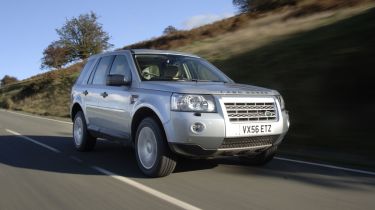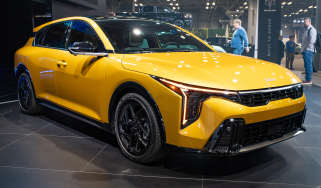Land Rover Freelander TD4 HSE
The traditionally-superb ride's still there but the price is expensive in this company
The original Freelander had to soldier on for nine years before Land Rover produced a replacement. But although it fell off the pace in terms of ability, sales never wavered – such is the power of the brand that the model was the UK’s most popular compact SUV right up to the end.
And the second generation is sure to take over where its predecessor left off. For starters, although the Freelander 2 has been made to look chunkier and more modern, the styling does nothing to alienate owners of the existing machine. The proportions are the same, as are details such as the clamshell bonnet, slightly stepped roofline and bulbous nose. However, this upmarket appearance coincides with an increase in price.
Not that you’re getting much more metal for your money. Land Rover resisted the temptation to increase the dimensions of the five-door monocoque frame too much, so the newcomer is only 50mm longer, although width and height have grown 109mm and 32mm respectively.
Those hoping the Freelander would now better the class-leaders in terms of cabin space and practicality will be disappointed. There are no packaging ‘miracles’. The rear doors are short, and once you’re inside, legroom is no more generous than in the X-Trail. Meanwhile, the high-floored boot isn’t the most spacious.
Used - available now

2022 Nissan
Micra
22,169 milesManualPetrol1.0L
Cash £10,700
2015 Volvo
S60
78,200 milesManualPetrol1.6L
Cash £7,400
2016 Tesla
Model S
78,000 milesAutomaticElectric
Cash £18,999
2019 Nissan
Micra
17,450 milesAutomaticPetrol1.0L
Cash £13,199The seats fold conventionally to create a maximum 1,670-litre area – well up on its 1,555-litre predecessor, but a huge 543 litres down on the Hyundai. While the Freelander is practical, we’d have liked to see more family-friendly features.
Most of the work has been put into the driving environment instead. As with the old car, you sit high, the window line is low and you can see the bonnet, so the Freelander is easy to place on the road – handy for parking. The driving position is superb and the switchgear clearly marked and well laid out. Ergonomically it’s very good, and it’s classy, too. The dash looks fresh and uses better materials (we really like the rattan-style floor mats). Yet the fit and finish are no real improvement over the Hyundai, and there are fewer stowage options.
Still, the all-new TD4 diesel gives the Santa Fe’s excellent VGT unit a run for its money. Developed with PSA Peugeot Citroen, it’s the most powerful engine here. It pulls well from under 1,500rpm, and despite the weight it has to cope with (1,955kg in top-spec guise), never needs to be worked hard. Smooth, quiet and capable, it’s a big step forward from the old unit.
The same applies to the chunky shift action of the six-speed manual gearbox. It’s good to use, as are the brakes, which remain firm underfoot. But the Land Rover’s trump card is the way it drives. In this respect, it’s ahead of every rival. Off-road, it inspires more confidence and has better traction (although the far lighter X-Trail ran it very close), while it excels on tarmac, too. The Land Rover is the quietest, most comfortable and stable car at speed, and even on rough roads there are few unwanted vibrations through the sturdy frame.
It’s not as sporty as the CR-V, but that doesn’t matter in an SUV. Rather, the newcomer scores as it covers ground quickly, efficiently and effortlessly – thanks to the excellent suspension and superbly accurate and informative steering. Yet while higher prices make the Freelander more exclusive, they’re also likely to take it beyond many buyers’ budgets.
Details
Price: £30,935
Model tested: Land Rover Freelander TD4 HSE
Chart position: 1
WHY: The new Freelander is a very British product, as it was designed at Gaydon, Warks and is built at the Halewood plant on Merseyside. The nine-strong model line-up includes two engines and prices range from £20,935 to £33,990.
Economy
Fuel efficiency has never been a Land Rover strong point, and the Freelander is no exception. Despite long gearing, its weight blunts economy. We only averaged 28.4mpg – the worst figure here.
Residuals
At launch, the first Freelander fared well, but a reputation for fragility hit residuals – three year-old cars are now worth only around 41 per cent of their new price. However, we reckon this model will perform very strongly.
Servicing
The first Freelander suffered quality and reliability niggles, so Land Rover needs to prove this car is better engineered and won’t require as frequent dealer visits. Services are 15,000 miles apart, but are likely to be costly.
Tax
Prepare for big bills if you want to run a Freelander as your company car. Despite the new engine, the car’s weight drives up CO2 emissions to 194g/km. Factor in the high price, and it will cost £600 more than any rival.







